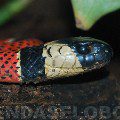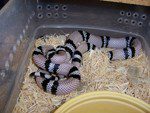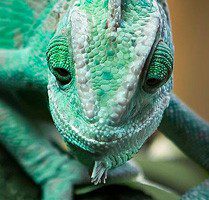
Chameleon Yemeni
This type of chameleon, due to its unpretentiousness in maintenance and speed of reproduction, is often kept by beginner terrariumists. This species got its name from the state of Yemen (Arabian Peninsula), the territory of which is their natural habitat. The Yemeni chameleon is one of the largest representatives of its family. In length, males reach 60 cm, females are inferior to them in size. Their coloration is very diverse, and males are more variegated: on a green background, three yellow spots stand out brightly on the sides, framed by orange and brown transverse stripes. Yemeni chameleons easily converge in captivity.
Contents
Taxonomy
Kingdom: Animals
Type: Chord
Class: Reptiles
Order: Scaly
Suborder: Lizards (Sauria)
Family: Chameleon (Chamaeleonidae)
Species: Yemeni chameleon (helmeted) Chamaeleo calyptratus
Subspecies: Nominative Yemeni chameleon (Chamaeleo calyptratus calyptratus)
spur-bearing Yemeni chameleon (Chamaeleo calyptratus calcarifer)
Etymology, synonyms, names in other languages
Chameleon (Chamaeleo) helmeted (calyptratus – with a cap, with a cover) is called “Yemen” based on the habitat of the species.
Also, the Yemeni chameleon is called the veiled or secretive chameleon – Veiled Chameleon (English) / Jemenchamäleon (German).
Subspecies
There are 2 subspecies of the Yemeni chameleon:
Chamaeleo calyptratus calyptratus – nominative Yemeni chameleon (usually it is he who is kept in captivity)
Chamaeleo calyptratus calcarifer is a spur-bearing Yemeni chameleon.
Habitat
 S. s. Calyptratus usually live high in the mountains (~3500 m a.s.l.) in northern Yemen. The climate there is dry and temperate, temperature fluctuations are small.
S. s. Calyptratus usually live high in the mountains (~3500 m a.s.l.) in northern Yemen. The climate there is dry and temperate, temperature fluctuations are small.
S. s. Calcarife, in contrast, live in the hot desert regions of the east coast of Saudi Arabia and southern Yemen.
The climate in which the Yemeni chameleon lives is very different: the humid coastal plains, the mountains of Yemen (Chamaeleo calyptratus calyptratus), the desert dry areas of the east coast of Saudi Arabia (Chamaeleo calyptratus calcarifer). Perhaps it is precisely because of the difference in climatic conditions that this species adapts so well to life in captivity – it has learned to adapt to completely different conditions.
Description
 The Yemeni chameleon is one of the most unpretentious species in breeding. They differ in beauty and large size: males can grow up to 60 cm in length, females are slightly smaller. Also the length depends on the species: C. c. calyptratus grows up to 30-60 cm, and C. c. calcarifer up to 15-45 cm.
The Yemeni chameleon is one of the most unpretentious species in breeding. They differ in beauty and large size: males can grow up to 60 cm in length, females are slightly smaller. Also the length depends on the species: C. c. calyptratus grows up to 30-60 cm, and C. c. calcarifer up to 15-45 cm.
The Yemeni chameleon is easily recognizable by its high helmet-shaped outgrowth-comb (in males it grows up to 10 cm, in females it is much smaller). The color of the males is brighter – green with three yellow spots on the sides, framed by orange and brown transverse stripes. The tail is also striped. In addition to the crest and color, males can be recognized by the heel “spurs”, which are located on the back of the leg above the foot.
Like all chameleons, it is able to change color depending on the environment. However, this ability has its limits – if you put a chameleon on a gray-brown-crimson towel with silver specks and a red stripe, it will not become the same.
The life expectancy of the Yemeni chameleon is up to 5-7 years. Due to the ability to change color, they easily adapt to completely different climatic conditions, including life in captivity.
Each chameleon keeps within its own personal territory. Activity shows mainly during the day. The main habitat of the Yemeni chameleon is the branches and leaves of trees, but it can also hide on the ground – in burrows, at the roots of trees, among stones. In the heat it climbs higher – it is ventilated.
Food
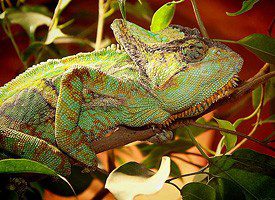 The nutrition of chameleons in nature and in captivity is not too different – they eat various invertebrates – small insects (crickets, cockroaches, etc.), arachnids, worms, as well as plant foods – fresh leaves, shoots and some fruits (bananas, for example). Males can occasionally, once a month, be pampered with mice, and females can be fed small lizards.
The nutrition of chameleons in nature and in captivity is not too different – they eat various invertebrates – small insects (crickets, cockroaches, etc.), arachnids, worms, as well as plant foods – fresh leaves, shoots and some fruits (bananas, for example). Males can occasionally, once a month, be pampered with mice, and females can be fed small lizards.
Normally, the ratio of animal feed to plant food in the diet of the Yemeni chameleon should be 9:1.
They should be fed daily, periodically changing feed.
Fresh clean water should always be in the drinker!
One of the most important parts of the diet is mineral supplements, supplements and vitamin preparations. Crushed eggshells and calcium-containing preparations are suitable as additives, but one should not forget about concentrated special vitamin supplements for reptiles. Unlike folk remedies, they are already well balanced and provide reliable prevention of beriberi. Mineral water (non-carbonated, of course) can also be added to the drinker.
Reproduction
 Yemeni chameleons, like most lizards, are oviparous. Sexual maturity is reached after 2 years.
Yemeni chameleons, like most lizards, are oviparous. Sexual maturity is reached after 2 years.
Their mating period is from March to September, and the female can lay up to 5-7 clutches per season.
Chameleons begin to prepare for mating immediately after they leave the winter: they are irradiated with a UV lamp and fed with vitamin preparations for 2-3 weeks. Only after this, males and females can be planted together. Males immediately try to show themselves in the best light – their coloration becomes brighter, they pout, trying to look bigger and stronger, as well as swaying and nodding their heads. If the female is ready for mating, she responds to the male in the same way, if not, she becomes aggressive. At the same time, it darkens and hisses. The process itself does not last long, 5-15 minutes. After intercourse, the females darken and no longer allow the male to approach them.
In order for the female to lay her eggs in 30-50 days, it is necessary to properly prepare the terrarium. A container with a mixture of sand and another component (peat, coconut substrate or earth) is placed in it. The mixture should be constantly wet, it is here that the female lays and buries her eggs – there are usually quite a lot of them, from 15 to 90 pieces (on average 30-45)
Freshly laid masonry is not left in the terrarium, but placed in an incubator (27-29 ْ).
After 6, 5 – 9 months, babies hatch.
Content
Necessary equipment for keeping a chameleon in a terrarium:
1. Terrarium
2. Fluorescent lamp for lighting
3. Fluorescent lamp for UV irradiation
4. Incandescent lamp or IR lamp for heating (or thermal stone, thermal cord or thermal mat)
5. Temperature regulator
6. Thermometer in a warm corner (or a thermometer combined with a hygrometer)
7. Sprinkler (or sprayer or fogger)
8. Feeder
9. Poilka
10. Tweezers (or corsangs)
Chameleon terrariums come in different types: vertical/horizontal, decorative/collectible/quarantine, single/rack. It is not the appearance of the terrarium itself that is important, but good ventilation. To do this, you can make holes from the mesh on the front wall and ceiling, or tighten the entire wall with a mesh.
It is also important to take care of the right lighting. Because The Yemeni chameleon grows rapidly, it needs a lot of calcium, and calcium is poorly absorbed without vitamin D3, which is synthesized in the skin of the chameleon under the influence of UV radiation. The ultraviolet part of the spectrum of solar waves does not enter the terrarium through the glass walls, so fluorescent lamps with UV radiation function are needed to irradiate the terrarium. The light of the lamp must fall on a specially placed reflector, while the reflected light must fall on the chameleon. In the winter months, animals need rest, the daylight hours should be gradually reduced from 12 to 6 hours, the heating time should also be reduced and it should be completely turned off at 6 hours of daylight. Then they stop feeding the lizards, and after a week they are transplanted into a wintering terrarium without heating. Wintering lasts up to 2 months, the temperature during it should be maintained at the level of 12ْ-15ْ, and the soil should be sprayed once a week.
In addition to the UV fluorescent lamp, an incandescent lamp (~40-60 W) is needed to heat the terrarium.
It is desirable to maintain a background temperature of 27°-29°, the daytime maximum at the heating point is 29°-31°, and the nighttime minimum is 24°. For daytime heating of a chameleon, 12 hours a day during the active season is enough.
Humidity in the terrarium also needs to be constantly maintained equal to 30-50%. To do this, it is enough to spray the terrarium from a spray bottle once a day or put a fog generator in it. It is the sprayer that supplies the terrarium with drinking water, since chameleons practically do not drink standing water from the drinking bowl. Usually, a dropper drinker is hung on the wall, the water from which periodically drips into a bowl at the bottom. You can also put a waterfall and arrange a stream. For complete protection against dehydration, you can water the chameleon yourself with their pipettes 1-2 times a week.
Due to the aggressiveness of the Yemeni chameleons, 2 males are not kept together. They usually fight and can cause serious damage to each other. But 1 male easily tolerates several females.
Additionally
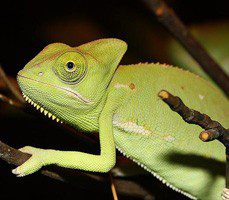 Before you start a chameleon, keep in mind that you will need to consider the following factors:
Before you start a chameleon, keep in mind that you will need to consider the following factors:
1. Age. You should not take too young a chameleon – younger than 3 months. Yemeni chameleons are often kept in captivity due to their fecundity and showy appearance, but there is little to no fresh blood flow of natural free chameleons. Therefore, crossing takes place among relatives, and this is fraught with birth defects, which usually appear before 3 months. If a chameleon survives into childhood, with proper care, it will live for a long time to come.
2. Conditions of birth. It is better to buy a chameleon from breeders, as freshly caught in the steppe often have a parasitic infection.
3. Limbs should be straight, not curved. Also, a healthy Yemeni chameleon does not have problems with movement – such problems indirectly indicate a lack of calcium.
4. The eyes of a healthy chameleon are open most of the day. Closed eyes indicate extreme fatigue, and sunken eyes indicate dehydration.
5. Color is important too. In a diseased or frozen chameleon, the color is extremely dark or gray, in a healthy one it is green.
6. Teeth and mouth are checked for inflammation. This is easy, as chameleons often hiss. It is enough to fix the chameleon, and then lightly stroke it around the eyes. As soon as he opens his mouth and hisses, look for yellow-green abscesses.
And remember – the Yemeni chameleon is not a living toy, he does not like to sit on his hands.
Sources:
http://vitawater.ru
http://zooclub.ru
http://chamaeleon.ru
http://www.terrariy.ru
http://www.hameleoni.ru
http://www.vitawater.ru




